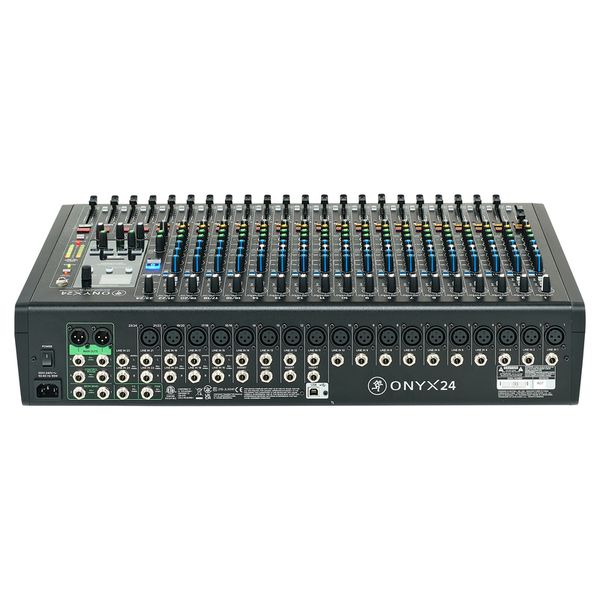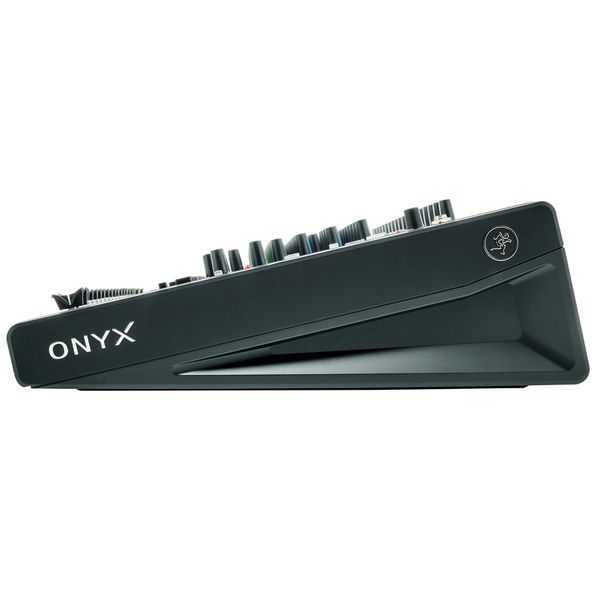I am transitioning from a Phonic Helix Board 18 firewire to a Mackie Onyx 22. I was quite happy with the capabilities of the Phonic but not with its build quality. After six years of wiggling and soldering, I got sick of it and bought the Mackie Onyx 22.
CHANNELS
The Phonic had 14 input channels, so the apparently much bigger Mackie with its 22 channels should be a massive upgrade, but it is not. The Phonic has two additional stereo returns and a stereo "tape" input. This adds up to 20 input channels. On paper, the Mackie has just two more.
However, four of the five stereo line-level channels are dual use and can be switched to SC-card, USB1, USB2 and Bluetooth input respectively. Nice.
The input gain dials get quite sensitive when you approach full gain and the last 20 dB are difficult to control. If you need to use two channels for a stereo source or a stereo return, it gets tricky to get both channels to the same level.
Four of the stereo line-level channels additionally have one(!) mic/XLR input. Their gain dials control the mic/XLR input, but don't do anything for the line inputs. However, if you use the mic/XLR input, you loose one channel. Only the last stereo channel (21/22) doesn't have a mic/XLR input and its gain dial does control its line input level.
Each channel has an illuminated Mute button, which turns red, when the channel is muted. In my set up, many channels are muted most of the time. The un-muted ones are difficult to spot in that sea of red. I would have preferred a green "On" button.
CONNECTORS
Virtually all connectors are at the back of the Mackie. I quite like that, as it keeps the "user interface" free of cables. Whether or not this is a problem, when cables need to be connected and disconnected frequently remains to be seen. Unfortunately, the inputs don't perfectly align with the channel strips and I accidentally used a wrong input a couple of times.
It isn't completely obvious that the Mackie has only four channels inserts. I used to populate the 6 inserts of my Phonic with compressors. This made the gain dials a bit more forgiving and the LED meters of the compressor made up for the lack of channel meters. I liked the compressors particularly for electric bass. I had high hopes for the two hi-Z inputs 1 and 2 of the Mackie. But inserts are not available for these, but only for channels 11-14. Other than that, the hi-Z inputs are a big plus.
SENDS AND RETURNS
The Mackie has three sends, two pre ("MON") and one post-fader ("FX"). You cannot change the pre/post routing for any of these.
There are no dedicated return channels, you need to use regular channels instead. This is quite nice, as long as you have enough channels. It gives you EQ for the returns and the possibility/danger to create loops.
EFFECTS
The built-in effects are remarkably similar to the ones of my Phonic. Both have two chorus effects for reasons unknown. The Mackie has more possibilities and a much nicer UI to tweak the effects. Unfortunately, it always activates DELAY after power-on instead of the active effect at power-off.
The "easy" effects DELAY, CHORUS and FLANGER are good. REVERB however, requires significant expertise to design well and it is pretty much unusable both in the Mackie and the Phonic. This also the case for combination effects, like REVERB+CHORUS. There is still a place for my aged SPX-90.
USB
The digital connection to my DAW is always pre-fader/EQ. The Phonic allowed switching between pre and post for each channel, even though I never used post.
I like the four digital (USB) return channels, as opposed to the two of my Phonic. Two of them are used for the output of my DAW (MusE-sequencer BTW). But I can additionally use my computer as a digital effect rack, using the remaining two channels as Returns without messing up my main setup.
So far, I have not yet discovered any problems connecting the Mackie to my Linux computer. I am hiding the Mackie from pulseaudio and use it exclusively with jackd. Currently it is running with 8.71 ms latency (good) with not much going on. With 4.35ms, it runs into xruns right away. I don't know yet if I have to increase the latency when my DAW manages more tracks and plugins.
BLUETOOTH
I thought I had no need for another Bluetooth receiver, as my computer has one already. But connecting a Phone to the Mackie is easier and more intuitive than doing the same with my computer. My vocal coach now uses the Mackie's Bluetooth input to play "listen to that" material to me.
RECORDING
I tested recording to SC card and it works. However, I will probably stick to my DAW for recording. There I can start a recording from anywhere, using a hotkey of my air mouse keyboard, whereas with the Mackie, I have to sit in front of it. Also, the Mackie only records two channels and the user-interface is as crude as you would expect it from a device without keyboard or mouse.
BUILD QUALITY
As of now, I cannot say much about the build quality. This will be judged in a year or two. It certainly feels sturdy, it is quite heavy but still easy to carry due to the two handles as its sides. Faders and dials run creamy and give some resistance.
CONCLUSION
So far I'm happy with my purchase. There were no major headaches or bad surprises, it just works. If the build quality holds up, the price is quite adequate.

































